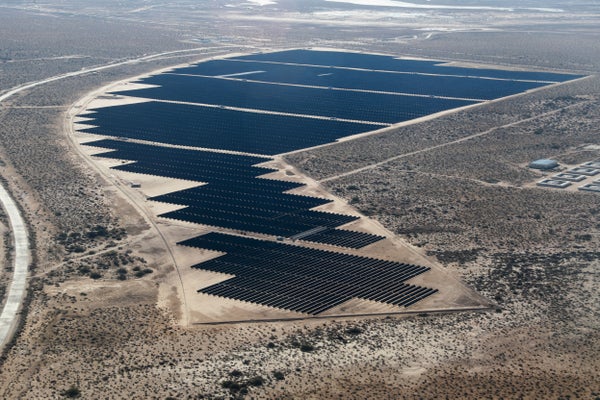CLIMATEWIRE | Global electricity demand will step up its rate of growth over the next three years — but the additional power use will be covered by low-emissions sources, according to a report released Wednesday by the International Energy Agency.
The IEA’s Electricity 2024 report forecasts that renewable energy is set to overtake the world’s use of coal by early 2025 and will account for more than one-third of the world's total electricity generation. At the same time, nuclear power generation is forecast to reach record highs by 2025, rebounding from recent declines.
By 2026, the report projects, renewables and nuclear will account for almost half of the world’s power generation. In 2023, by contrast, they were less than 40 percent. The outlook is key because the United Nations has said a move to clean energy will be key to limiting global warming to 1.5 degrees Celsius — or as close to that as possible — compared with the preindustrial era.
On supporting science journalism
If you're enjoying this article, consider supporting our award-winning journalism by subscribing. By purchasing a subscription you are helping to ensure the future of impactful stories about the discoveries and ideas shaping our world today.
IEA Executive Director Fatih Birol said in a statement that it’s “encouraging that the rapid growth of renewables and a steady expansion of nuclear power are together on course to match all the increase in global electricity demand over the next three years.”
“This is largely thanks to the huge momentum behind renewables, with ever cheaper solar leading the way, and support from the important comeback of nuclear power, whose generation is set to reach a historic high by 2025,” Birol said. “While more progress is needed, and fast, these are very promising trends.”
At the COP28 climate summit in Dubai, United Arab Emirates, in December, negotiators agreed to a road map for “transitioning away from fossil fuels,” as well as a commitment to triple renewables capacity by 2030.
The changing electricity mix will drive down emissions from the power sector — currently the world’s largest source of carbon dioxide emissions — even as demand rises, the IEA said. Electricity demand grew just 2.2 percent globally in 2023, lower than the 2.4 percent increase a year before, according to the agency. Demand is forecast to accelerate, with a 3.4 percent yearly average between 2024 and 2026.
That increase is driven by a number of factors, including the electrification of homes and businesses, the growing role of electric vehicles, and industrial growth.
Data centers are also driving significant growth around the world. The IEA projects that electricity use from data centers globally could double between 2022 and 2026, reaching a demand roughly equivalent to Japan’s. The agency said that updated regulations and technological improvements “will be crucial to moderate the surge in energy consumption” from data centers.
Crucially, that growth in demand will be decoupled from a rise in emissions. After a 1 percent increase in 2023, global emissions from the electricity sector are set to fall by over 2 percent in 2024, followed by smaller declines in the subsequent two years. The reduced carbon intensity of electricity generation will be felt around the world, which the IEA said means that emissions savings through electrification of cars and appliances “will become even more substantial.”
Despite the trend toward zero-emission sources, natural-gas-fired power is set to rise slightly over three years as it replaces coal power. Europe has been responsible for sharp declines in gas power, the report found, but that was offset by growth in the United States and projected gains in Asia, Africa and the Middle East thanks to the availability of liquefied natural gas supply.
Still, fossil fuels are expected to fall to 54 percent of global generation in 2026, the first time they will be below 60 percent in the IEA records going back more than 50 years. In 2023, that figure was 61 percent. That drop would be an “important milestone,” said Eren Çam, one of the report’s authors, in a press event Tuesday.
In the U.S., electricity demand is projected to rise 2.5 percent in 2024 and average 1 percent annually in the following two years, although that will depend on weather. In 2023, for example, demand dropped 1.6 percent in part because of milder weather, the IEA said.
Fueled in part by the 2021 bipartisan infrastructure law and the Inflation Reduction Act of 2022, the U.S. is poised to increase renewable generation around 10 percent each year between 2024 and 2026, surpassing coal generation in 2024, according to the IEA. Gas, however, is expected to remain stable in the U.S. for power generation. The result is a projected overall reduction in power sector emissions of 4 percent a year through 2026.
The report’s authors warned of potential trouble spots that could blunt clean energy trends.
For example, drought conditions and early snowmelt sapped hydropower production across the world last year, leading countries to rely more on existing coal and gas plants. Extreme weather events that threaten electricity reliability could further drive countries to rely on fossil fuels. New wind, solar and nuclear projects are also threatened by global supply chain interruptions and permitting delays.
Keisuke Sadamori, the IEA’s director of energy markets and security, said the findings show important progress on the path to meeting U.N. global emissions reduction goals.
Speaking to reporters Tuesday, he cautioned that countries will still need to invest in a rapid build-out of transmission and other grid infrastructure to integrate the coming renewable energy and continue the power sector’s trends.
“The world needs to work hard,” said Sadamori.
Reprinted from E&E News with permission from POLITICO, LLC. Copyright 2023. E&E News provides essential news for energy and environment professionals.
